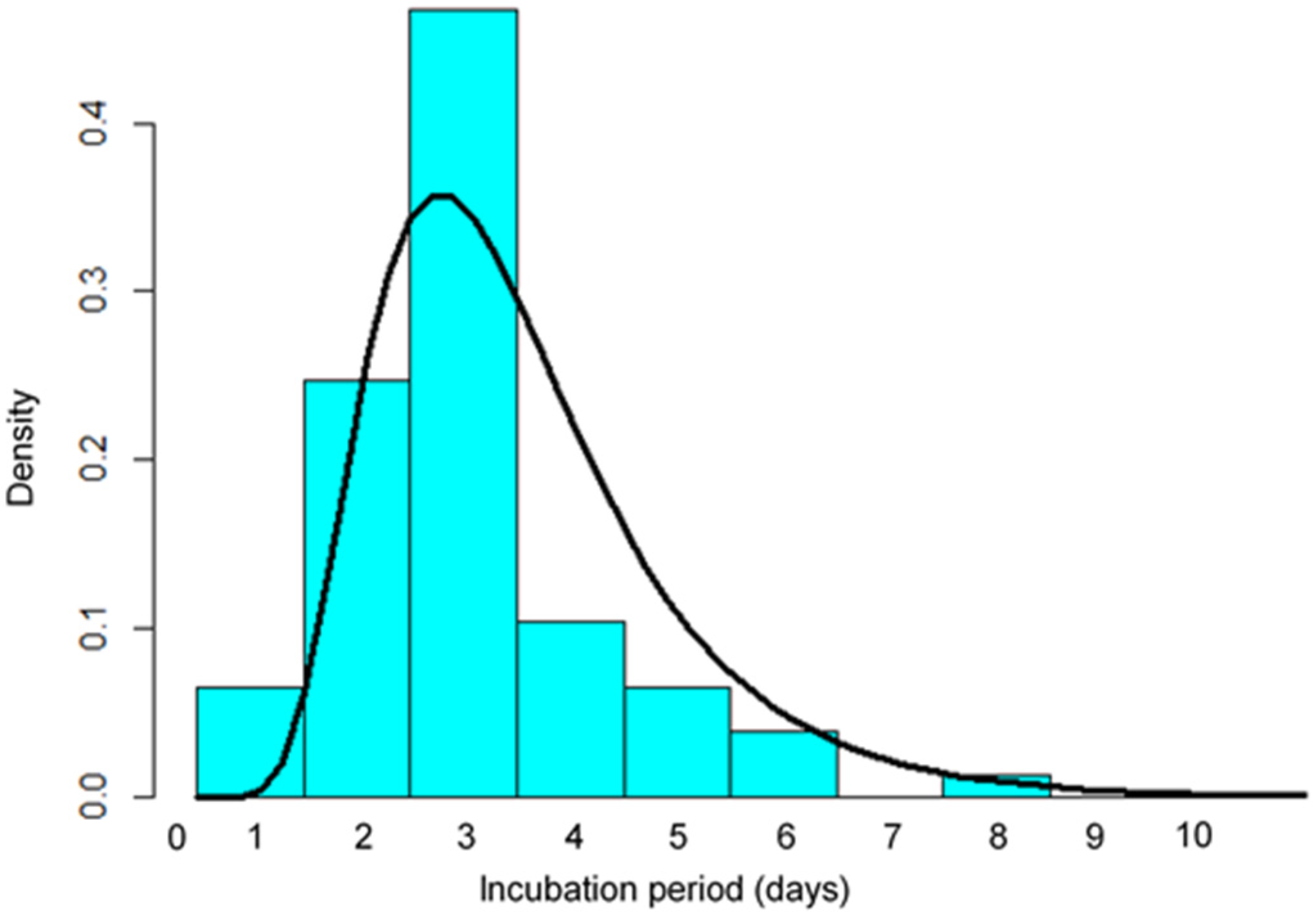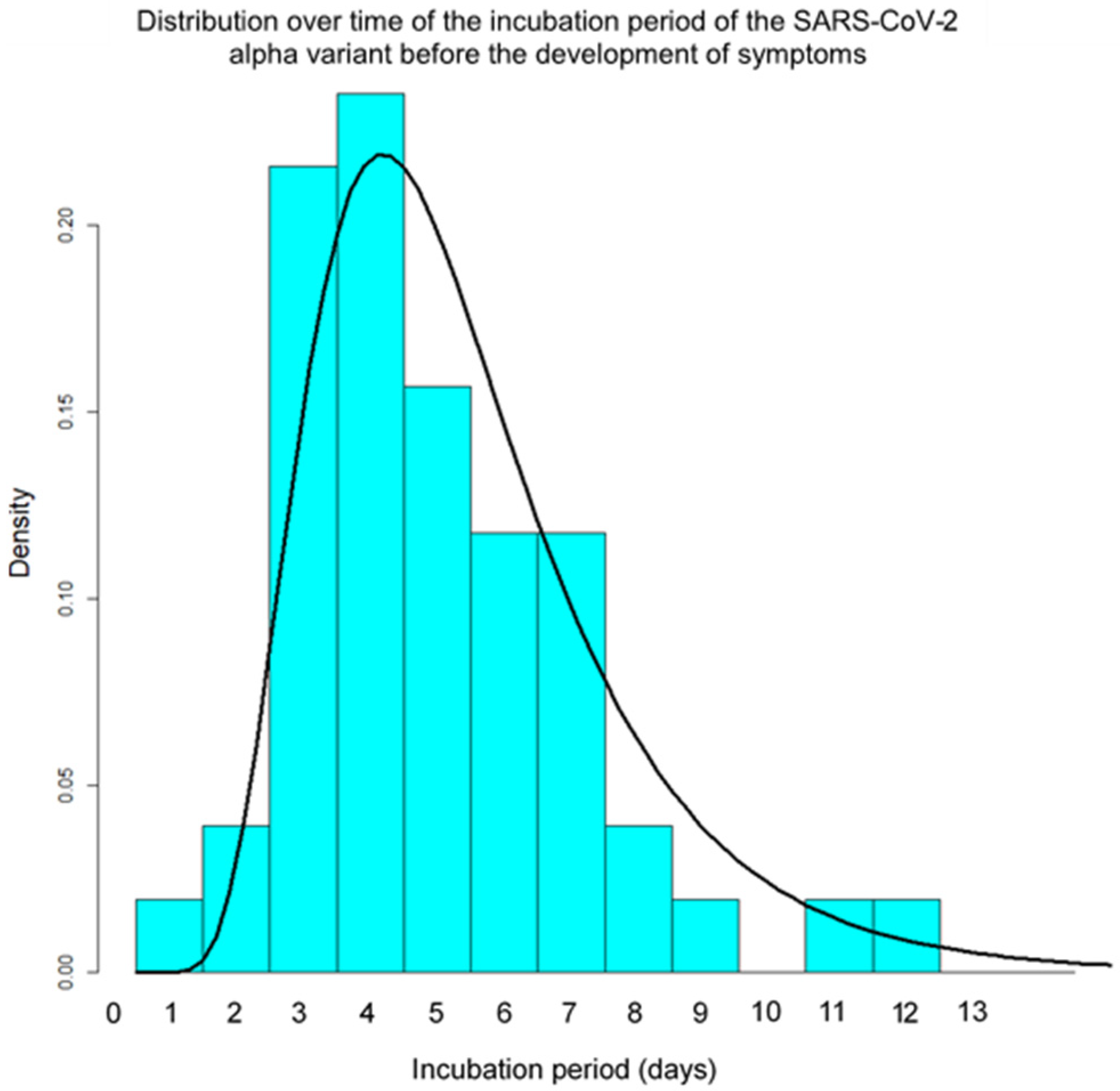Shorter Incubation Period among COVID-19 Cases with the BA.1 Omicron Variant
Abstract
:1. Introduction
2. Materials and Methods
2.1. Subjects
2.2. Data Items
2.3. Identification of the SARS-CoV-2 Omicron and Alpha Variants
2.4. Statistical Methods
3. Results
4. Discussion
5. Conclusions
Author Contributions
Funding
Institutional Review Board Statement
Informed Consent Statement
Data Availability Statement
Acknowledgments
Conflicts of Interest
References
- World Health Organization. Enhancing Readiness for Omicron (B.1.1.529): Technical Brief and Priority Actions for Member states. Available online: https://www.who.int/publications/m/item/enhancing-readiness-for-omicron-(b.1.1.529)-technical-brief-and-priority-actions-for-member-states (accessed on 20 March 2022).
- Ministry of Health, Labor and Welfare. COVID-19 variant of concern in Japan. The 70th COVID-19 Advisory Board Meeting (2 February 2022). Available online: https://www.mhlw.go.jp/content/10900000/000892298.pdf (accessed on 30 March 2022).
- Lyngse, F.P.; Mortensen, L.H.; Denwood, M.J.; Christiansen, L.E.; Moller, C.H.; Skov, R.L.; Spiess, K.; Fomsgaard, A.; Lassauniere, M.M.; Rasmussen, M.; et al. SARS-CoV-2 omicron VOC transmission in Danish households. medRxiv 2021. [Google Scholar] [CrossRef]
- Ito, K.; Piantham, C.; Nishiura, H. Relative instantaneous reproduction number of Omicron SARS-CoV-2 variant with respect to the Delta variant in Denmark. J. Med. Virol. 2022, 94, 2265–2268. [Google Scholar] [CrossRef] [PubMed]
- Ogata, T.; Tanaka, H.; Irie, F.; Hirayama, A.; Takahashi, Y. Shorter incubation period among unvaccinated delta variant coronavirus diseases 2019 patients in Japan. Int. J. Environ. Res. Public Health 2022, 19, 1127. [Google Scholar] [CrossRef] [PubMed]
- Ministry of Health, Labor and Welfare. COVID-19 variant of concern in Japan. The 38th COVID-19 Advisory Board Meeting (1 June 2021). Available online: https://www.mhlw.go.jp/stf/seisakunitsuite/bunya/0000121431_00256.html (accessed on 30 March 2022).
- COVID-19 Surveillance Weekly Report. The National Institute of Infectious Diseases, Tokyo. Available online: https://www.niid.go.jp/niid/ja/2019-ncov/2484-idsc/10754-2021-41-10-11-10-17-10-19.html (accessed on 30 March 2022).
- Lessler, J.; Reich, N.G.; Brookmeyer, R.; Perl, T.M.; Nelson, K.E.; Cummings, D.A. Incubation periods of acute respiratory viral infections: A systematic review. Lancet Infect Dis. 2009, 9, 291–300. [Google Scholar] [CrossRef]
- Xin, H.; Wong, J.Y.; Murphy, C.; Yeung, A.; Ali, S.T.; Wu, P.; Cowling, B.J. The incubation period distribution of coronavirus disease 2019(COVID-19): A systematic review and meta-analysis. Clin. Infect Dis. 2021, 73, 2344–2352. [Google Scholar] [CrossRef] [PubMed]
- Backer, J.A.; Eggink, D.; Andeweg, S.P.; Veldhuijzen, I.K.; Maarseveen, N.; Vermaas, K.; Vlaemynck, B.; Schepers, R.; Hof, S.; Reusken, C.B.; et al. Shorter serial intervals in SARS-CoV-2 cases with Omicron BA.1 variant compared with Delta variant, the Netherlands, 13 to 26 December 2021. Eurosuveill 2022, 27, 2200042. [Google Scholar] [CrossRef] [PubMed]
- Cui, Z.; Liu, P.; Wang, N.; Wang, L.; Fan, K.; Zhu, Q.; Wang, K.; Chen, R.; Feng, R.; Jia, J.; et al. Structural and functional characterizations of infectivity and immune evasion of SARS-CoV-2 Omicron. Cell 2022, 185, 860–871. [Google Scholar] [CrossRef] [PubMed]
- Ejima, K.; Kim, K.S.; Ludema, C.; Bento, A.I.; Iwanami, S.; Fujita, Y.; Ohashi, H.; Koizumi, Y.; Watashi, K.; Aihara, K.; et al. Estimation of the incubation period of COVID-19 using viral load data. Epidemics 2021, 35, 100454. [Google Scholar] [CrossRef] [PubMed]
- Ito, K.; Piantham, C.; Nishiura, H. Estimating relative generation times and relative reproduction numbers of Omicron BA.1 and BA.2 with respect to Delta in Denmark. medRxiv 2022. [Google Scholar] [CrossRef]



| n | Mean | SD | p-Value | ||
|---|---|---|---|---|---|
| Total | 172 | 2.85 | 1.20 | ||
| Age | 0–9 | 12 | 3.00 | 1.00 | 0.368 (a) |
| 10–19 | 23 | 2.91 | 0.78 | ||
| 20–39 | 91 | 2.90 | 1.14 | ||
| 40–59 | 13 | 3.23 | 2.12 | ||
| 60- | 33 | 2.45 | 1.05 | ||
| Vaccination status | Unvaccinated | 45 | 3.31 | 1.23 | 0.00416 (a) |
| Dose 1 | 3 | 2.33 | 0.943 | ||
| Dose 2 or 3 times | 118 | 2.65 | 1.25 | ||
| Unknown | 6 | 3.50 | 1.26 | ||
| Place | Restaurant/Karaoke/Bar/Party | 110 | 2.94 | 1.24 | 0.0588 (a) |
| Home/Car | 5 | 2.60 | 1.36 | ||
| Sports activity | 20 | 3.25 | 0.77 | ||
| Nursing home | 18 | 2.33 | 1.20 | ||
| Nursery school | 10 | 2.70 | 1.00 | ||
| Other/Unknown | 9 | 2.22 | 0.92 | ||
| variant | L452R(-) | 77 | 3.03 | 1.33 | 0.118 (b) |
| Untested/Unknown | 95 | 2.71 | 1.06 |
| Percentile | Group A (n = 172) | Omicron VOC (n = 77) | Alpha VOC (n = 51) | |||
|---|---|---|---|---|---|---|
| Incubation Period (Days) | [95%CI] | Incubation Period (Days) | [95%CI] | Incubation Period (Days) | [95%CI] | |
| 5th | 1.2 | [1.0–1.6] | 1.3 | [1.0–1.6] | 2.1 | [1.5–2.7] |
| 25th | 1.9 | [1.7–2.1] | 2 | [1.7–2.4] | 3.5 | [2.7–3.9] |
| 50th | 2.6 | [2.4–2.8] | 2.8 | [2.5–3.1] | 4.5 | [4.0–5.1] |
| 75th | 3.5 | [3.2–3.9] | 3.8 | [3.3–4.4] | 6.1 | [5.1–7.5] |
| 95th | 5.5 | [4.7–6.5] | 5.8 | [4.8–7.5] | 9.6 | [7.4–13.0] |
Publisher’s Note: MDPI stays neutral with regard to jurisdictional claims in published maps and institutional affiliations. |
© 2022 by the authors. Licensee MDPI, Basel, Switzerland. This article is an open access article distributed under the terms and conditions of the Creative Commons Attribution (CC BY) license (https://creativecommons.org/licenses/by/4.0/).
Share and Cite
Tanaka, H.; Ogata, T.; Shibata, T.; Nagai, H.; Takahashi, Y.; Kinoshita, M.; Matsubayashi, K.; Hattori, S.; Taniguchi, C. Shorter Incubation Period among COVID-19 Cases with the BA.1 Omicron Variant. Int. J. Environ. Res. Public Health 2022, 19, 6330. https://doi.org/10.3390/ijerph19106330
Tanaka H, Ogata T, Shibata T, Nagai H, Takahashi Y, Kinoshita M, Matsubayashi K, Hattori S, Taniguchi C. Shorter Incubation Period among COVID-19 Cases with the BA.1 Omicron Variant. International Journal of Environmental Research and Public Health. 2022; 19(10):6330. https://doi.org/10.3390/ijerph19106330
Chicago/Turabian StyleTanaka, Hideo, Tsuyoshi Ogata, Toshiyuki Shibata, Hitomi Nagai, Yuki Takahashi, Masaru Kinoshita, Keisuke Matsubayashi, Sanae Hattori, and Chie Taniguchi. 2022. "Shorter Incubation Period among COVID-19 Cases with the BA.1 Omicron Variant" International Journal of Environmental Research and Public Health 19, no. 10: 6330. https://doi.org/10.3390/ijerph19106330
APA StyleTanaka, H., Ogata, T., Shibata, T., Nagai, H., Takahashi, Y., Kinoshita, M., Matsubayashi, K., Hattori, S., & Taniguchi, C. (2022). Shorter Incubation Period among COVID-19 Cases with the BA.1 Omicron Variant. International Journal of Environmental Research and Public Health, 19(10), 6330. https://doi.org/10.3390/ijerph19106330






